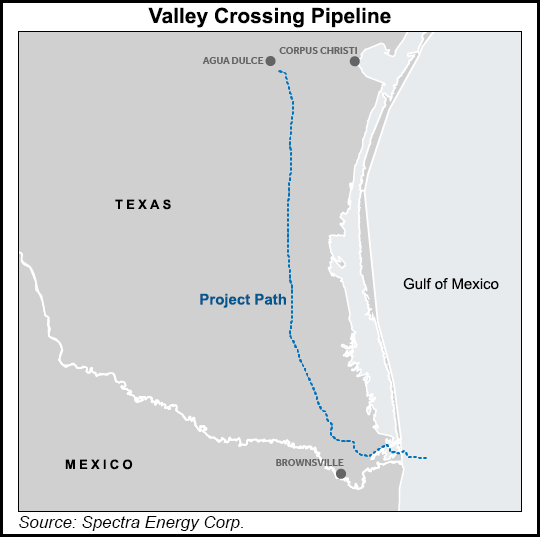Infrastructure | NGI All News Access
Construction Begins on Valley Crossing Tex-Mex Natural Gas Pipeline Project
Valley Crossing Pipeline LLC has begun building the Border Crossing Project, the Houston-based Enbridge Inc. subsidiary said in a filing at the Federal Energy Regulatory Commission.

Construction began last Tuesday on the project, which includes a 1,000-foot stretch of 42-inch diameter pipeline that would extend from a point in Texas state waters, about 30 miles east of Brownsville, to the international border with the Mexican state of Tamaulipas.
Rough weather in the nearby Gulf of Mexico had delayed the start of construction of a portion of the project. The delay involved the 1,000-foot section of FERC jurisdictional pipe in deeper water, but offshore construction in shallower water had already been progressing.
The project remains on track for October completion, an Enbridge spokesman recently told NGI’s Mexico Gas Price Index. Commissioning activities are expected to begin in the near future.
Valley Crossing received FERC authorization to begin construction of the Border Crossing Project three months ago. The Commission also approved the Houston-based company’s proposal to modify its tie-in methodology to conduct a subsea tie-in, rather than an above-water tie-in, which reduces potential stress on the pipelines and reduces the project’s environmental footprint.
FERC issued a presidential permit and granted authorization in October for Valley Crossing to construct and operate the 2.6 Bcf/d cross-border natural gas pipeline between Texas and Mexico, where it will be used for power generation and industrial customers.
Valley Crossing has said Infraestructura Marina del Golfo S de RL de CV (Marina), an unaffiliated Mexican pipeline, would construct 500 miles of subsea pipeline on the Mexican side of the border. The Sur de Texas-Tuxpan pipeline includes an interconnect to Mexico’s Sistrangas network at the Port of Tuxpan in Veracruz.
Natural gas transported through the pipeline is expected to fuel power plants owned by Mexico’s Comision Federal de Electricidad. Enbridge said it plans to enter the pipeline into service by October.
© 2024 Natural Gas Intelligence. All rights reserved.
ISSN © 2577-9877 | ISSN © 2577-9966 |
